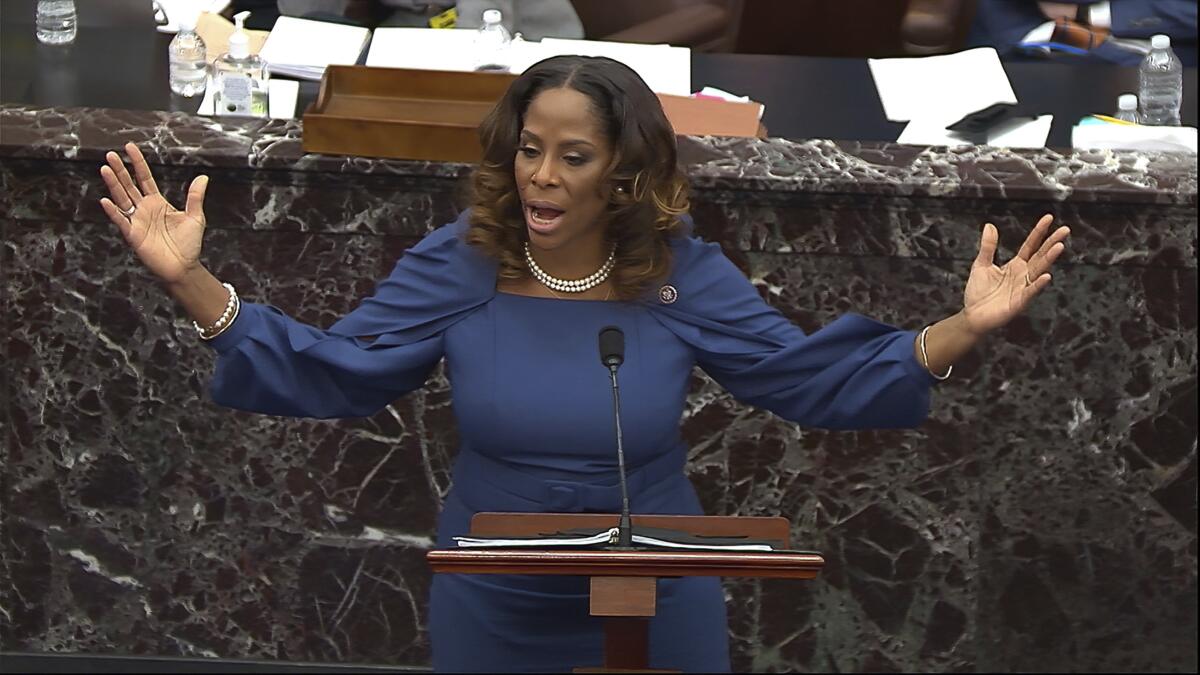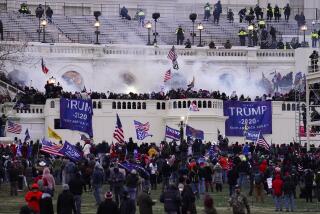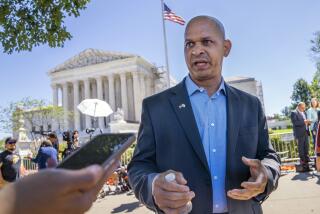Stacey Plaskett’s facts will convict Trump for history, if not for the GOP

- Share via
Making online drama come alive is not easy. Think of a time someone has tried to tell you about a social media showdown. It’s all retweets, likes, ghosting, blocking, emojis. Not exactly riveting.
That’s why it’s impressive that Stacey Plaskett, the House of Representatives delegate from the Virgin Islands, managed to dramatize the machinations of online political life so vividly in the impeachment trial of Donald Trump. In fact, Plaskett, a House impeachment manager, emerged at Wednesday’s hearing as the Homer of the proceedings — a masterful storyteller equal to the complex task of connecting virtual signals to real-world violence.
To prove to the Senate that Trump incited violence at the U.S. Capitol on Jan. 6, as the House’s single article of impeachment alleges, Plaskett brought more discipline than operatics to her presentation. Fact by fact, she took her audience through the tragedy of the Capitol attack, linking Trump’s tweets and the responses in online forums to the insurgency. Her goal was to show that “the violence was foreseeable,” in her words, if you just knew where to look.
Of course, not all of this is tricky. Plenty of evidence exists in plain sight.
We had already seen the now-infamous video of Trump’s speechifying on the morning of the insurrection. In the video, which has ricocheted across cable news and social media, Trump casts aspersions on then-Vice President Mike Pence and tells the crowd — which has been shouting, “Fight for Trump!” — to “fight like hell” and to march to the Capitol to give “weak Republicans” the “boldness” they need to “take back our country.”
The crowd did “fight like hell,” smashing windows and crashing down doors in a rampage that left five dead and more than 140 injured. One vigilante gang chanted, “Hang Mike Pence!”
That video evidence alone might have closed the case for the incitement charge, but Plaskett was much more thorough. She demonstrated how Trump’s calls to arms have played on the internet for months.
She led the senators through a thicket of social media arcana — tagging, quote-tweeting and framing. She even managed in a few words to show how a video can be doctored with music to make it serve a rhetorical purpose. When Trump approvingly tweeted a video showing his supporters being violent toward Biden supporters, he used a version that had been scored with a fight song.
With skill and brio — and without condescension — Plaskett spelled it out for senators of all ages, including Sen. Patrick J. Leahy (D-Vt.), 80, who is serving as the chamber’s president pro tem for the impeachment trial. When Leahy was born, cable television didn’t exist, much less the internet; he could be forgiven for not understanding. In Plaskett’s telling, the virtual drum beat for insurrection was loud and clear.
She also invoked the internet’s darker, shape-shifting recesses, including the notorious site 8kun (formerly 8chan), a den of QAnon followers and other far-right-wingers. Plaskett synced her explanation with a slide that spelled the site name, doubling the lesson for those new to the creepiest digital places where white supremacists and domestic terrorists gather.
But Plaskett’s particular skill was drawing the connection between these digital sewers and real-world violence. Consider just one example.
In the presidential debate Sept. 29, Trump was asked by the moderator to disavow white supremacist groups like the Proud Boys. Trump instead gave a cryptic “order” to the violent, far-right group: “Stand back and stand by.”
The words, as Plaskett showed with images from the web, were quickly interpreted to mean that right-wing militias should be at the ready. The phrase so delighted the Proud Boys, Plaskett explained, that they adopted it as their official slogan and emblazoned it on their branded merchandise. The shirts could be spotted at rallies where Trump drilled in the message that Biden and the Democrats had stolen the election.
Then, on Jan. 6, as Plaskett recounted, Dominic Pezzola and William Pepe, two of the leaders of the Proud Boys, stormed the Capitol. About 10 days later, they were duly arrested, charged with conspiracy and civil disorder, and, in Pezzola’s case, robbery and “assaulting, resisting or impeding” law enforcement.
Plaskett homed in on posts to sites where the insurrection was being organized, which Trump’s advisors had told reporters they were monitoring. Soon after Trump tweeted a save-the-date card, promising a “wild” event in Washington on Jan. 6, one supporter left no doubt about the endgame: “The Capitol is our goal. Everything else is a distraction. Every corrupt member of Congress locked in one room and surrounded by real Americans is an opportunity that will never present itself again.”
It’s extremely unlikely that two-thirds of the Senate will vote to convict Trump. Most Republicans have signaled as much, and some have been ostentatiously tuning out the prosecution’s presentations and even, disgracefully, leaving the chamber during the trial.
But Plaskett’s detailed chronicle of what happened Jan. 6, and what led up to it, writes hard, memorable facts into the record. What too many Republicans may be willing to ignore, historians and future generations will not.
At the start of her presentation, Plaskett told a story about her son, who believes she’s utterly unflappable. She laughed that off, but she admitted she was confident in the House case against the former president.
“I have learned throughout my life that truth and preparation will carry you far,” she said.
More to Read
A cure for the common opinion
Get thought-provoking perspectives with our weekly newsletter.
You may occasionally receive promotional content from the Los Angeles Times.









